A 50-inch TV used to be considered an impressive screen, but now they’re actually at the very start of being phased out as a screen size. What was once seen as a huge step up from the 32-inch and 40-inch displays that most people owned, the 50-inch size is often overlooked, with 55-inches being the preferred entry-level for big-screen TVs.
Don’t write them off completely though – this is a great time to buy a 50-inch TV, provided it’s the right screen size for your home. You can get a TV that, while not packed with the latest features, does offer great picture and sound quality and you don’t have to pay the high prices associated with larger screens.

But how do you know if a 50-inch TV is the right screen size for you? Should you aim a little higher, or is there actually a smaller TV that would be more suitable?
Let’s explore 50-inch TVs in a little more detail to help you decide.
- What is the actual size of a 50-inch TV?
- What does a 50-inch tv look like in a room?
- Is a 50-inch TV too big?
- How far should you sit from a 50-inch TV?
- How much does a 50-inch TV weigh?
- How high to mount a 50-inch TV on a wall
- How many watts does a 50-inch tv use?
- Is there a big difference between 50- and 55-inch TV?
What is the actual size of a 50-inch TV?
A 50-inch TV has a screen that measures 50 inches diagonally from corner to corner, ignoring the bezel. The screen is 43.6 inches wide and 24.5 inches tall, while the bezel will likely add a couple of inches to each dimension.
How big that bezel is – and the final dimensions of the whole TV – will vary from model to model. Cheaper TVs use a thicker bezel because it’s easier to manufacture a TV this way, while more premium TVs cut down on the bezel to almost completely get rid of it so that there’s no distracting border around the screen.
All TVs are measured from corner to corner in inches, even in countries where they tend to use centimeters as the main measurement. TV sizes are pretty standard, although some of them – 40-inch, 50-inch, 60-inch, and 70-inch – are starting to be phased out.
Here’s a guide to all the main TV screen sizes you can buy:
| Screen size | Width | Height |
|---|---|---|
| 32” | 27.9 inches | 15.7 inches |
| 40” | 34.9 inches | 19.6 inches |
| 43” | 37.5 inches | 21.1 inches |
| 50” | 43.6 inches | 24.5 inches |
| 55” | 47.9 inches | 27 inches |
| 60” | 52.3 inches | 29.4 inches |
| 65” | 56.7 inches | 31.9 inches |
| 70” | 61 inches | 34.3 inches |
| 75” | 65.4 inches | 36.8 inches |
| 80” | 69.7 inches | 39.2 inches |
| 85” | 74.1 inches | 41.7 inches |
What does a 50-inch tv look like in a room?
A 50-inch TV is considered a mid-sized TV and so how it looks in a room depends on the layout and size. In a small room, it will still be a large focal point but in a mid-sized room, it will look a lot smaller. It’s a good size to use on a TV stand or mounted on the wall.
When you stand next to a 50-inch TV on a stand, it will likely come up to your mid-riff or chest (depending on how tall you are!) It’s a comfortable size for one person to lift from the sides if needed.
Here’s what a 50-inch TV looks like next to an average-height man…
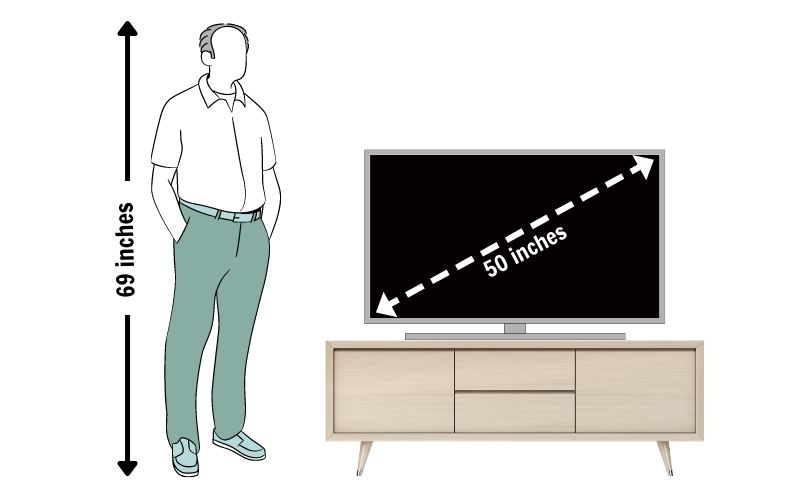
Is a 50-inch TV too big?
Whether a 50-inch TV is too big purely depends on the size and layout of your room and how far you’re sitting from the screen. Generally, a 50-inch TV is not considered to be a massive screen anymore – it’s at the very low end of those considered to be a big screen.
This means that for most people, a 50-inch TV won’t be too big. It’s only too big if it doesn’t fit on your stand. It’s likely too big for a kids’ room or your bedroom.
Is a 50-inch TV too big for a small room?
For a small room, a 50-inch TV may be too big but it depends on how far you’re sitting from the screen. In most cases, a 50-inch TV will work fine in a smaller room and will actually look more impressive, provided you don’t have to move your head to keep track of everything that’s happening.
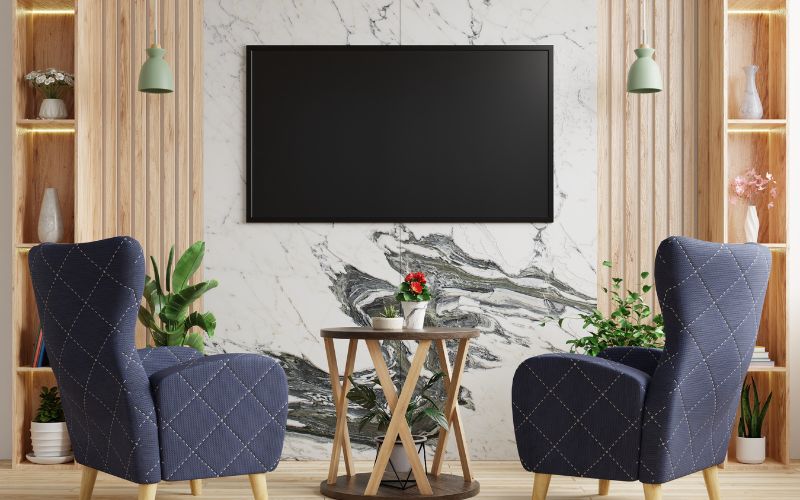
It’s not just about the size of the room but also the layout, and where you’re sitting in relation to the screen. If the room is small but you’re sitting in opposite corners, then the TV will appear smaller than if you’re sitting front-on to the screen in a slightly larger room. So bear that in mind.
Is a 50-inch TV too big for gaming?
For gaming, a 50-inch TV will likely be too big to use on a desk as part of a dedicated gaming setup. You’d need to sit too far from the screen to feel comfortable. As a gaming TV in a living room with a couch, a 50-inch TV is a perfectly fine choice.
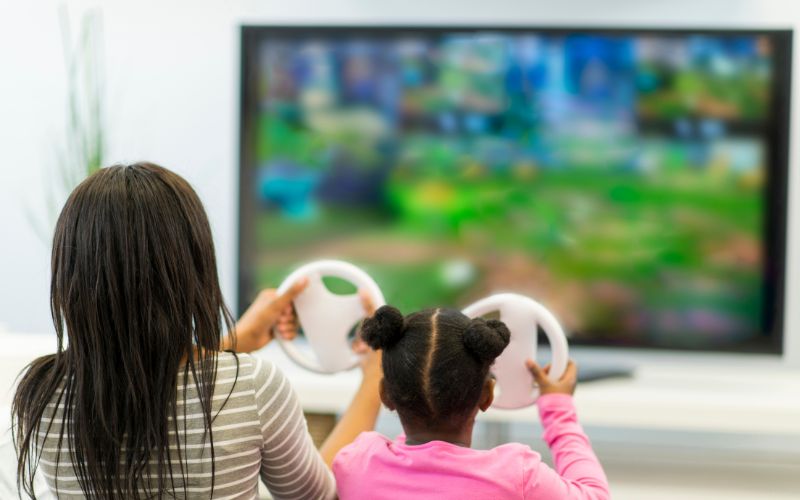
It’s worth noting that since a lot of manufacturers aren’t putting their best tech into the 50-inch range, you might actually get a better gaming experience by opting for a 43-inch model instead – the screen size may be smaller but you’ll be more likely to get advanced features like VRR and full 4K120 through HDMI 2.1.
Suggested read: 43 Vs 50 Inch TV Size Comparison
How far should you sit from a 50-inch TV?
The recommended best viewing distance for a 50-inch TV is 7 feet, although you don’t need to be exact. Sit a lot closer and you’ll struggle to see the entire screen without moving your head a lot. Sit much further away and you won’t see all the details on the screen.
Realistically, if you sit somewhere between 6 and 8 feet from the TV then 50 inches is a good size. But if your room has the TV closer or further away then it’s better to consider a different screen size.
Here’s a full list of the best viewing distances for every TV:
| Screen size | Optimal Viewing Distance |
|---|---|
| 32” | 4 – 4.5 feet |
| 40” | 5.5 feet |
| 43” | 6 feet |
| 50” | 7 feet |
| 55” | 7.5 feet |
| 60” | 8 – 8.5 feet |
| 65” | 9 feet |
| 70” | 9 – 9.5 feet |
| 75” | 10.5 feet |
| 80” | 11 feet |
| 85” | 11.5 – 12 feet |
How much does a 50-inch TV weigh?
A 50-inch TV will usually weigh between 25 and 35 pounds (roughly 11 to 16kg), with the actual weight defined by how thick the TV is and how well made it is. Usually, premium TVs weigh less because they’re designed to be thinner, with more invested into making a lightweight, slim TV.
50-inch TVs are a suitable weight for wall mounting, as long as you buy a mount that meets these weight brackets. Most do, except for those specifically targeted at smaller 32-inch TVs, so as long as you check the spec when you buy it should be fine.
Be aware that the design of the TV’s stand will also impact its weight if you don’t want to wall-mount it. TVs with separate feet tend to be lighter, while those with a central stand have to be heavier so that the stand can keep the screen anchored and prevent it from easily being knocked over.
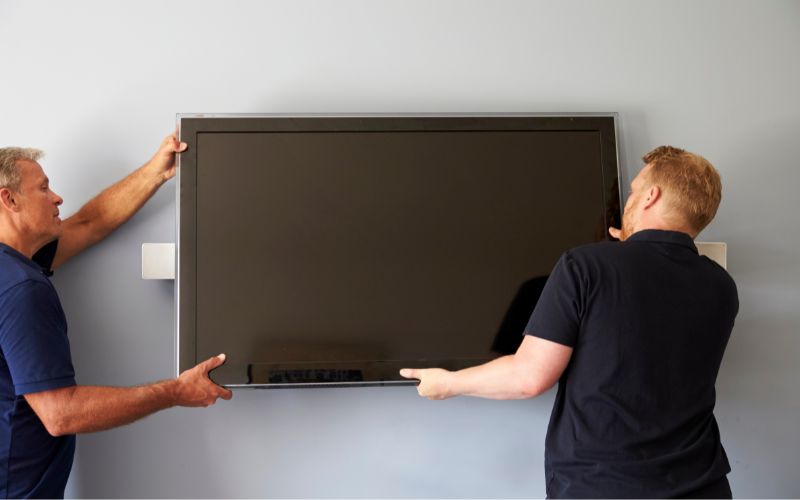
How high to mount a 50-inch TV on a wall
There’s some debate over how high to mount a 50-inch TV on the wall, but most recommend that you have the center of the screen around 58 inches from the floor. That means that the bottom edge of the screen should be around 46 inches off the ground.
If you prefer, you can mount the TV higher up the wall instead and use a tilting mount so that it is angled downwards. This is good if you tend to recline on your couch, and is also useful for reducing the glare on your screen, although the installation tends to be a little tricker.
How many watts does a 50-inch tv use?
A 50-inch TV uses approximately 45 watts of power when it’s powered on, and around 0.5 watts of power when in standby mode. Most people watch their TV for 3 hours a day, which equates to around 1 kilowatt-hour per week if you include standby time.
Taking the average cost of electricity in the US as $0.14 per kilowatt-hour, this means you’re spending just 14 cents per week to run the TV, or around $7.30 a year, which isn’t a lot at all really.
The difference between screen sizes isn’t huge either when you look at it by cost – a larger, 55-inch TV will cost around $10 a year, so only a couple of bucks more.
OLED displays use more power, but you don’t tend to find 50-inch OLED screens anymore. Instead, manufacturers make them at 48-inches, which is close enough for a fair comparison. A 48-inch OLED display uses around 89 watts of power, essentially double a 50-inch LED model.
Read more: How much electricity does a TV use?
Is there a big difference between 50- and 55-inch TV?
There aren’t huge differences between 50-inch and 55-inch TVs. A 55-inch TV is marginally longer and taller, and costs around an extra $2.70 per year to run.
You can compare the sizes in this diagram…
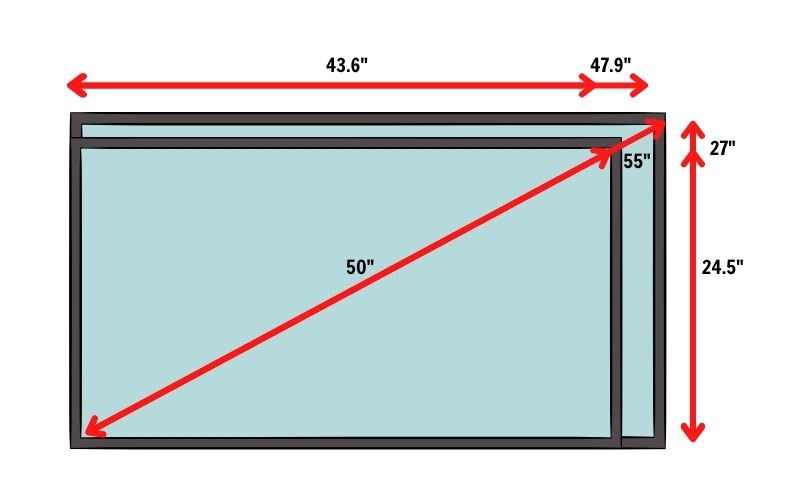
55-inch TVs are becoming the more popular choice for manufacturers though – it’s easier to cut the screen sizes for these TVs in a cost-effective way, and the extra few inches sound better from a marketing perspective. That’s why 55-inch TVs generally have better features.
Suggested read: 50 Vs 55 Inch TVs Compared
There are still some great 50-inch TV options but expect the screen size to be gently phased out over the coming years.

The Bottom Line
If you want a big-screen TV but you don’t really have the room for one, then a 50-inch TV could be the ideal compromise. They aren’t really considered large anymore but they’re not small either, and there are some great features available to make your viewing experience better.
If budget isn’t an issue, then you might prefer to step down slightly and get a 48-inch OLED, but for the best value TV that offers something close to the big screen experience, 50-inch models are a solid choice.
